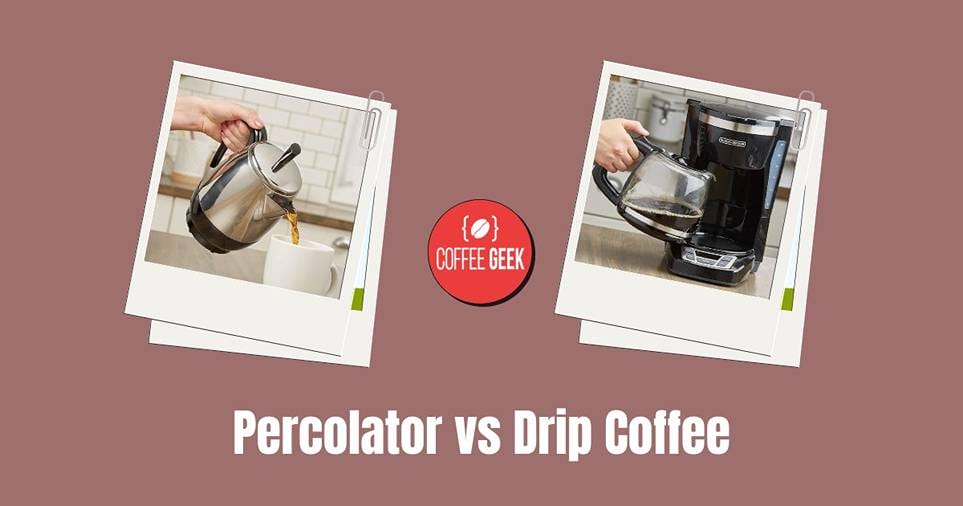Coffee enthusiasts often find themselves debating the merits of different brewing methods, and two popular options are percolators and drip coffee makers.
Both methods produce distinct flavors and offer unique advantages, but understanding the differences can help you make the best decision for your personal taste and lifestyle.
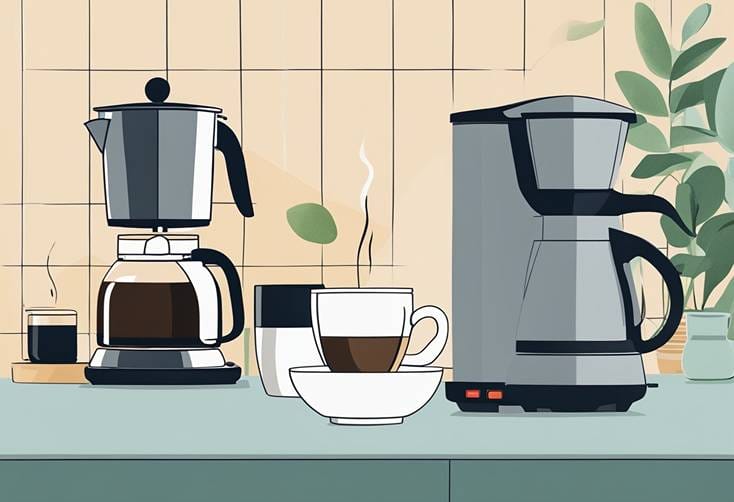
Percolators, which have a nostalgic charm for many coffee lovers, utilize a repeated boiling and cycling process to create a strong, bold flavor.
On the other hand, drip coffee makers, a more modern and widespread option, use a process in which hot water is gradually dripped over coffee grounds, resulting in a well-balanced and customizable cup of coffee with a milder aroma.
As you consider which option is best for you, it’s essential to take into account factors such as brewing time, processes, and your individual preferences.
Key Takeaways
- Percolators create strong, bold coffee while drip coffee makers produce a well-balanced and customizable cup.
- Consider brewing time and processes when choosing between percolator and drip coffee makers.
- Personal taste and practical considerations should guide your decision in selecting the best brewing method for you.
Percolator vs Drip Coffee Brewing Time
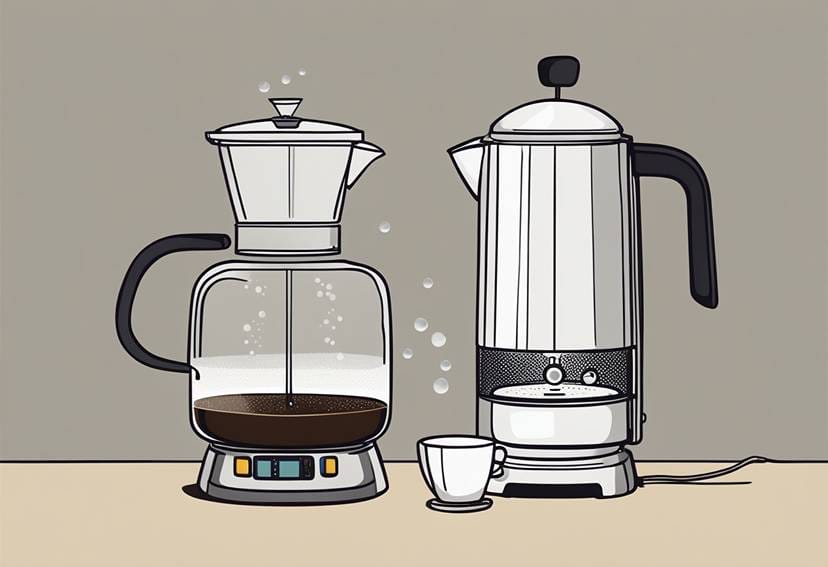
When comparing percolator and drip coffee methods, understanding the differences in brewing time can greatly influence your decision.
In this section, we will discuss how each method’s brewing time impacts the resulting coffee.
Percolator brewing time: A percolator continuously cycles boiling water through coffee grounds, extracting the coffee’s flavors and oils.
This process usually takes around 5 to 10 minutes depending on the type of percolator and chosen coffee strength.
It’s important to keep a close eye on the percolator to avoid over-extraction, which can result in a bitter taste.
Drip coffee brewing time: In contrast, drip coffee makers work by pouring hot water over ground coffee beans placed within a paper or metal filter.
The brewing time for a drip coffee maker averages around 4 to 6 minutes.
This process allows the coffee to retain a milder and smoother flavor when compared to percolator coffee.
From these comparisons, you can see that the brewing time for these coffee making methods differ slightly.
To summarize:
- Percolator brewing time: 5 to 10 minutes
- Drip coffee brewing time: 4 to 6 minutes
Keep in mind that brewing time is only one factor to consider when choosing between a percolator and a drip coffee maker.
Ultimately, you should choose the brewing method that best suits your taste preferences and lifestyle.
Comparing Brewing Processes

Coffee Flavor and Oils
When comparing percolator and drip coffee, a key difference lies in the flavor and oils of the coffee.
As you use a percolator, the process repeatedly passes boiling water over the coffee grounds, creating a bold flavor and extracting more oils from the beans.
This results in a full-bodied, rich flavor with a more intense taste.
However, it might also cause the coffee to have a bitter taste due to over-extraction.
On the other hand, drip coffee uses gravity to pass water through the coffee grounds and a filter.
It leads to a smoother, more subtle flavor as the filter traps most of the oils.
Thus, the coffee has a delicate taste with less bitterness.
Temperature and Extraction
The temperature and extraction methods play a crucial role in the brewing process. In percolator coffee, water reaches boiling point which might lead to over-extraction and higher bitterness.
Nevertheless, this results in a more intense, bold flavor with a full-bodied profile, preferred by some drinkers.
Drip coffee brewers keep the temperature between 195-205°F, ideal for extracting flavor compounds from the coffee grounds without causing excessive bitterness.
Overall, the brewing time for drip coffee is usually shorter, around 3-5 minutes compared to 7-10 minutes for a percolator.
In summary, while percolator coffee offers a bold and intense flavor with a rich, full-bodied taste, it has the drawback of potential excessive bitterness.
Drip coffee, on the other hand, produces a smoother, more delicate flavor with less bitterness, but might lack the boldness preferred by some coffee enthusiasts.
Consider your personal preferences and prioritize the desired flavors when deciding between these two brewing methods.
Understanding Coffee Brewing Basics
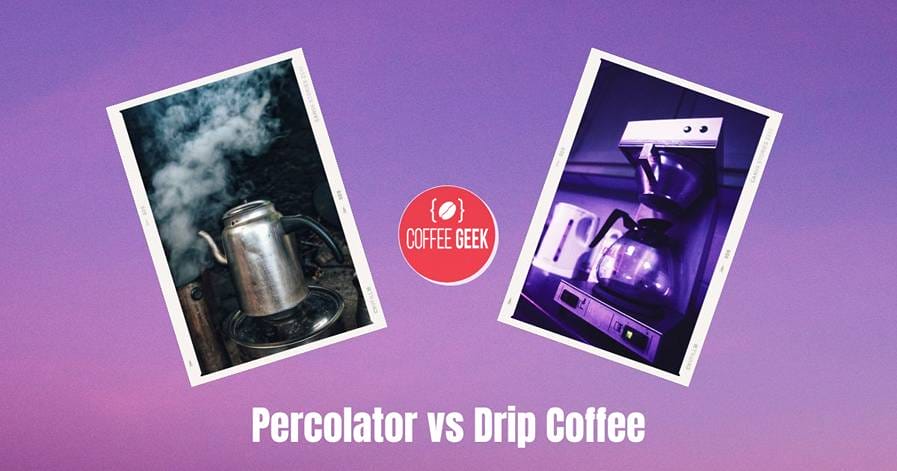
Coffee Brewing Methods
There are several coffee brewing methods that can impact the taste and quality of your cup of coffee.
Two popular methods are percolator and drip coffee.
The percolator method is known for its bold, rich flavor and higher caffeine content, while drip coffee produces a more subtle flavor, often resulting in a smoother cup of coffee.
In the percolator method, boiling water and steam repeatedly pass through coffee grounds, extracting bold flavors. However, it can also cause the coffee to taste bitter.
On the other hand, the drip method involves pouring hot water over coffee grounds in a filter, allowing the flavorful liquid to drip slowly into a carafe below.
This slower process typically results in a cleaner cup of coffee with less bitterness.

Components of Coffee Makers
Understanding the components of coffee makers can help you choose the right brewing method for your taste preferences.
As you consider these factors, it’s essential to find a balance between the brewing method, coffee maker components, and your personal taste preferences.
By understanding the basics of coffee brewing methods and coffee makers, you can better determine which brewing method will deliver the perfect cup for your taste buds.
Percolator Coffee Makers
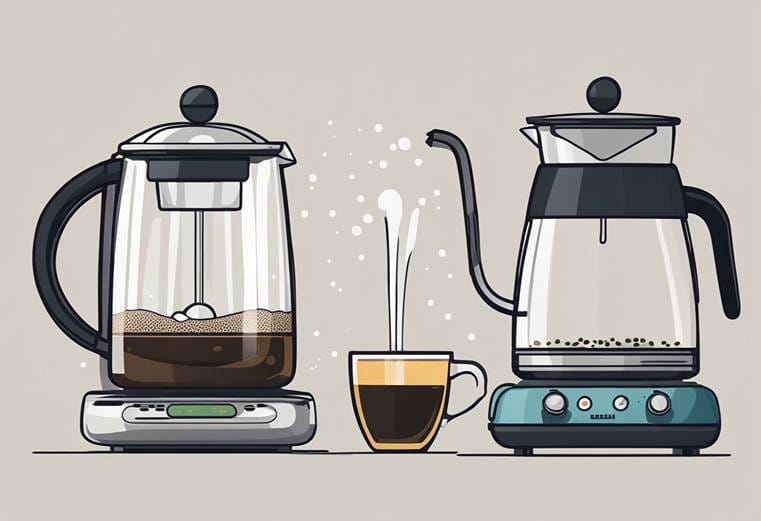
How Percolators Work
A percolator is a type of coffee maker that uses a unique brewing process to create a stronger, richer cup of coffee.
In a percolator, water begins in the bottom pot and is heated until it reaches boiling.
This boiling water then travels through a tube and is dispersed over the coffee grounds, which are held in a metal filter basket at the top of the percolator.
The brewed coffee then drips back down into the bottom pot, and the process repeats until reaching the desired strength.
This method of brewing, known as percolation, creates a more robust flavor than traditional drip coffee makers.
It extracts more of the coffee grounds’ natural oils and releases them into the pot, resulting in a bolder, richer taste.
The Appeal of Percolator Coffee
There are several reasons why you prefer a coffee percolator might be over drip coffee.
One of the main appeals is the strong, robust flavor that the percolation process provides.
The boiling water extracts a more intense flavor from the coffee grounds, which can be especially appealing to those with a taste for strong coffee.
Another advantage of percolator coffee makers is their versatility.
While many percolators are electric, there are also stovetop models available.
Stovetop percolators are an excellent option for those who enjoy brewing over an open flame or for those who want a portable coffee maker for camping or other outdoor activities.
Finally, percolators are often appreciated for their simplicity and nostalgia methods of brewing coffee.
With their traditional design and straightforward brewing process, percolator coffee makers can bring back fond memories for those who grew up with them in their homes.
Overall, the appeal of percolator coffee lies in its unique brewing method, which produces a strong, rich flavor that stands out from more common drip coffee.
Its versatility and nostalgic charm make it an attractive choice for coffee enthusiasts who want a break from the ordinary.
Drip Coffee Makers

Mechanics of Drip Brewing
Drip coffee makers function by utilizing the simple force of gravity. In a typical setup, you fill the water reservoir with your desired amount of water.
This water is then heated and distributed evenly over your coffee grounds, which are held in a filter basket containing a paper filter or a permanent metal filter.
These filters prevent the grounds from ending up in your final brew.

As the hot water passes through the coffee grounds, it extracts the flavors and caffeine from them, ultimately dripping into the carafe below.
The drip method is a popular choice among coffee enthusiasts due to its ease-of-use and ability to produce consistent results.
Most drip coffee makers come equipped with additional features, such as programmable settings and warming plates to maintain the temperature of your coffee after brewing.
Benefits of Drip Coffee
Drip coffee makers offer various advantages over other brewing methods, including:
- Consistency: The controlled temperature and brewing process deliver a largely uniform taste with each brew, ensuring you enjoy your coffee just the way you like it.
- Ease of use: Drip coffee makers are straightforward to operate, making them an excellent choice for those new to coffee brewing or with busy schedules.
- Customizability: With options for adjusting the brewing strength, you can easily tailor your coffee to your personal taste preferences.
- Capacity: Drip coffee makers come in various sizes, allowing you to cater to your needs, whether it’s brewing a single cup or a full carafe for multiple people.
By choosing a drip coffee maker, you are opting for a reliable and accessible brewing method that consistently delivers delicious coffee.
While there are other brewing methods available, such as percolators or espresso machines, the drip coffee maker remains a popular choice for its versatility and user-friendly design.
So go ahead and invest in a drip coffee maker to enjoy a consistently great cup of coffee every time.
Practical Considerations for Users

When choosing between a percolator and a drip coffee maker, it’s essential to consider some practical aspects, such as cleaning and maintenance, ease of use and convenience, and cost and budget considerations.
Cleaning and Maintenance
Percolators require a bit more effort to clean, as they have multiple components that need to be disassembled and cleaned separately.
However, this can also be seen as a benefit, as it allows for thorough cleaning and ensures all parts are residue-free.
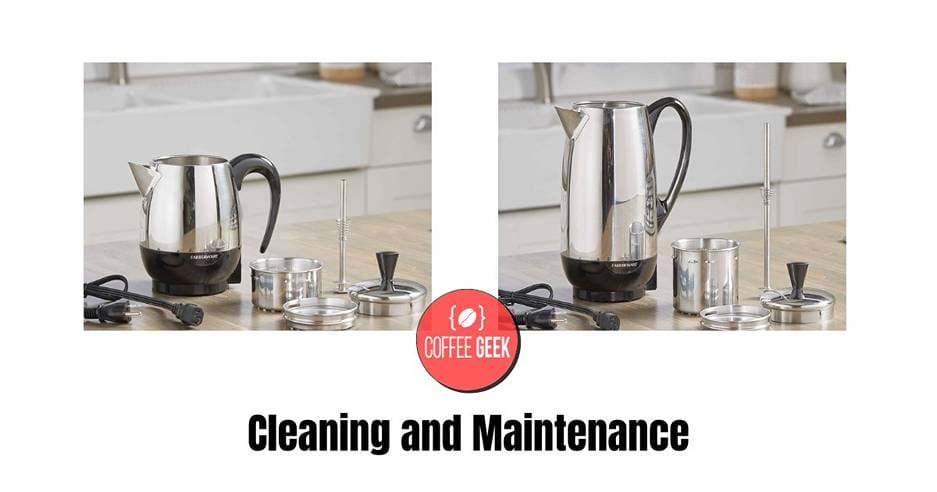
Make sure to clean it after each use to maintain its efficiency.
Drip coffee makers are generally easier to clean, as most components are dishwasher-safe, and only the carafe and filter basket need to be cleaned regularly.
However, it’s recommended to descale the machine periodically to remove mineral buildup and prolong its lifespan.
Overall, drip coffee makers are considered easier to clean than percolators.

Ease of Use and Convenience
When it comes to ease of use, drip coffee makers are generally more user-friendly and convenient.
You simply need to add water, coffee grounds, and press a button to start brewing.
Many models also feature programmable timers, making it easy to have your coffee ready when you wake up.
On the other hand, percolators, especially stovetop models, require more attention during the brewing process.
You need to monitor the heat and brew time to achieve your desired strength.
Electric percolators may be more convenient compared to stovetop ones but still involve more manual input than drip coffee makers.
Cost and Budget Considerations
When considering cost, percolators often have a lower upfront expense, with stovetop versions ranging from $30 to $80, while electric percolators can be bought for around $45.
Drip coffee makers can range significantly in price, with budget models starting at $30, going up to high-end models that cost over $120.
The cost will depend on the number of features and the quality of the particular model.
In conclusion, it’s crucial to weigh these practical considerations based on your personal preferences and daily coffee habits when deciding between a percolator and a drip coffee maker.
| Aspect | Percolator Coffee | Drip Coffee |
|---|---|---|
| Brewing Method | Recirculates boiling water through grounds | Passes hot water through grounds once |
| Brewing Time | Typically longer, around 5-10 minutes | Generally quicker, around 5 minutes |
| Temperature Control | Less precise, tends to boil the coffee | More precise, controlled temperature |
| Flavor Profile | Often stronger and more robust | Generally smoother and milder |
| Ease of Use | Requires monitoring and timing | Easy to use, set it and forget it |
| Cleanup | May require disassembly for cleaning | Easy cleanup with disposable filters |
| Portability | Less portable due to size and weight | More portable, suitable for travel |
| Brew Volume | Typically brews larger quantities | Can brew small to large quantities |
| Popularity | Less popular in modern households | Widely used in households and cafes |
Conclusion
When comparing a percolator vs drip coffee maker, coffee enthusiasts often debate which method produces the best cup of joe.
The choice between these two popular brewing methods depends largely on personal preferences and the type of coffee experience one is seeking.
A coffee percolator, often seen as a classic coffee maker, has a long history in the world of coffee brewing.
It operates by heating water that circulates through coffee grinds, often resulting in a stronger coffee.
The percolator works by forcing water up through a tube and over the coffee grinds repeatedly.
This method can sometimes burn the coffee if not monitored closely, but it is favored by many for producing a robust and flavorful cup.
The basic percolator, such as a stovetop percolator, allows for more control over the brewing process but requires more attention during brewing.
On the other hand, modern drip coffee makers offer a more automatic drip process where water is heated and then drips through coffee grounds in a drip area, usually using a paper filter.
Drip machines are arguably the most popular brewing method today due to their convenience and ability to produce a decent cup of coffee with minimal effort.
Many coffee drinkers find that a drip coffee maker in almost any setting can produce a great cup of coffee without much hassle.
The automatic nature of the drip brewer ensures the coffee doesn’t get over-extracted and burnt, unlike percolated coffee which might need more supervision.
For those who prefer a stronger, bolder flavor, a percolator might be the way to go.
However, if you’re looking for convenience and a consistently good taste, using a drip coffee maker might be your best bet.
While the drip coffee maker vs percolator debate continues, both methods have their merits and can produce amazing coffee.
Ultimately, it comes down to personal taste and how much coffee you intend to make and store.
Whether you use a drip or a percolator, both can produce coffee that keeps you warm and satisfied.
Frequently Asked Questions

What’s the difference between a percolator vs drip coffee maker?
The main difference between a percolator and a drip coffee maker is in the way of making coffee – the way to brew coffee.
A percolator cycles boiling water through coffee grounds using gravity until the desired strength is reached.
On the other hand, a drip coffee machine sprinkles water over coffee grounds and then collects the infused coffee in a pot below, following the drip brewing process.
Can you tell me about the history of the percolator and the history of the drip coffee?
The coffee percolator dates back to the early 19th century and was popular due to its simplicity and economics.
However, with the introduction of automatic drip coffee machines in the 1970s, the popularity of coffee percolators declined.
The drip coffee machine quickly became popular because it was easy to use and able to yield a good tasting coffee.
How can I make coffee at home using a coffee percolator and a drip coffee machine?
Making coffee at home with these coffee machines is quite simple.
For the percolator, you add water to the base, coffee grounds into the basket, and heat it until the coffee is the strength you prefer.
With a drip coffee machine, you add water to the reservoir, a coffee filter and coffee grounds to the designated area, and then you start the machine for it to brew the coffee.
What are the key differences in taste when using a percolator coffee vs drip?
The key differences in taste between percolator coffee vs drip come down to brewing methods.
Percolated coffee tends to be stronger and sometimes more bitter because the water passes through the grounds multiple times.
Drip brewing process usually yields a smoother and more balanced cup of coffee.
Is it possible to use a drip coffee maker to replicate French Press coffee recipes?
It’s difficult to replicate the exact taste of French press coffee recipes using a drip coffee maker because the brewing methods are different.
French press allows full immersion of coffee grounds producing a stronger, fuller-bodied coffee.
Drip coffee makes a cleaner, lighter cup. But feel free to experiment to create great coffee that suits your taste!
How to decide which is the best for me, a percolator or a drip coffee machine?
The best coffee pot for you depends on your coffee preferences and lifestyle.
Percolators are good for stronger coffee, large amounts, and are more portable.
Drip coffee machines are convenient, ideal for mild coffee, and come with features like timers and keeping your coffee warm.
Consider pros and cons of each in the context of your needs to decide which is best.
Can I use the same grind for my percolator and my drip coffee machine?
No, usually different grinds are suggested for different coffee machines.
A coarser grind is recommended for percolators to prevent the coffee from over-extraction which can lead to bitter coffee.
For drip coffee machines, a medium grind is typically recommended for a balanced extraction.
What’s a quick method for brewing coffee if I’m new to using a drip coffee maker?
Using a drip coffee maker is easy! You only need to fill the reservoir with water, place a filter in the coffee basket, add your ground coffee to the filter, and start the machine.
The machine will then heat the water and sprinkle it over the coffee grounds, resulting in an already brewed coffee collecting in a pot below.
Do percolators or drip coffee machines make a stronger cup of joe?
Generally, percolators make a stronger cup of joe since the water cycles through the coffee multiple times.
However, the strength of the brew can be adjusted with both types of machines, by using more or less coffee, and also by adjusting the brewing time in the case of a percolator.
Can I try brewing more than one type of coffee in a percolator or drip machine?
Absolutely! Both coffee percolators and drip coffee machines can brew different types of coffee beans.
The trick is to find the grind and brewing time that works best for each type.
Go ahead and explore your store’s coffee aisle for a variety of beans to experiment with, keeping in mind those coffee recipes that enhance the features of each coffee.

